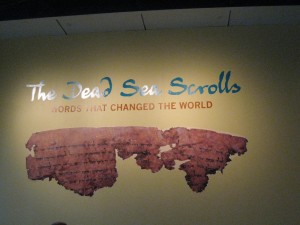Tag: dead sea scrolls’
The Mystery of the Dead Sea Scrolls
- by KitchenPantryScientist
This morning, a friend and I headed for the Science Museum of Minnesota to see the “greatest archeological find of the 20th century”, the Dead Sea Scrolls. A Bedouin goat herder stumbled on the first of the ancient scrolls in a cave near the Dead Sea in 1947. Eventually, 10 more caves containing scrolls were discovered near the first cave, and near the ancient ruins of a settlement known as Khirbet Qumran. Later, more scrolls were found in caves around the Dead sea and the Judean Desert. Altogether, more than 900 scrolls were discovered.
The scrolls were often contained in pottery jars, and though many of the scrolls are damaged, it is astonishing that so many of them are in good enough condition to read, or piece together. Two thousand years is a long time for a piece of parchment (animal skin) or papyrus (made from plants) to survive. Scientists attribute the miraculous preservation to the dry conditions in the caves. After all, you need moisture for microbe growth and decomposition.
Using radiocarbon testing, which takes advantage of the fact that all living things incorporate Carbon 14 when they are alive, scientists were able to determine that the scrolls dated from the centuries between 250 BCE and 68 CE. One of the first things I noticed in the exhibit was the use of the term BCE (before common era) and CE (common era), which correspond to B.C. and A.D., but are terms used by scientists.
On the scrolls were mostly words of Hebrew scripture, law and even poetry. Not all of the writing on the scrolls is religious, but the scrolls we viewed were copied from scripts that would one day appear in the Hebrew Bible and included an Apocryphal Psalm, attributed to King Solomon and to David. One scroll we saw was a passage from Genesis and all of the scrolls were copied down before the Hebrew Bible had been set in stone.
What fascinated me most about the exhibit was that the scrolls were copied down during such a tumultuous, pivotal time in the heart of a culture experiencing an uprising of the common people and the birth of Christianity. Archeaologists believe that even as scribes copied the some of the sacred texts onto the scrolls, Jesus was walking through the Holy Land with his disciples. Rome was gaining power in the region, and the Pharisees, representing the common people of Judea, were beginning to rise up against the Priests, or Sadducees, who tended to come from aristocratic families. The Pharisees believed in maintaining an oral tradition so that common people, many of whom could not read, had access to “God’s Word”, while the Sadducees believed in a written tradition, which they interpreted very strictly.
Archeologists and Biblical scholars tell us that Jesus was crucified and Christianity was born as modern Judaism was being shaped, the Judeans rose up against the Romans, and the Temple fell, for the second time, in 70 CE, shattering a way of life for many. Scholars don’t know for sure who hid the scrolls in the caves, or why. It’s a mystery, but there the ancient manuscripts sat, right before my twentieth century eyes, words marching across the page. They stared at me from the Minnesota Science Museum, a world away from where they were penned, a testament to a people who would not be forgotten and a time that changed the world.
